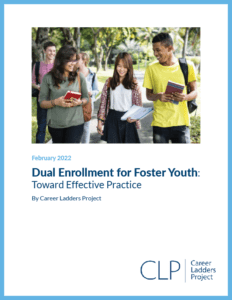 Dual enrollment holds the promise of successfully transitioning high school students into college with more degree completions in a shorter time. When implemented with quality, it has been shown to be particularly effective for students from groups who have been historically underserved, such as students of color and first-generation students. This suggests that dual enrollment could be particularly impactful in changing the college-going trajectory for foster youth.
Dual enrollment holds the promise of successfully transitioning high school students into college with more degree completions in a shorter time. When implemented with quality, it has been shown to be particularly effective for students from groups who have been historically underserved, such as students of color and first-generation students. This suggests that dual enrollment could be particularly impactful in changing the college-going trajectory for foster youth.
Three colleges were chosen to pilot what it might take to support foster youth in dual enrollment. The pilot project occurred over a 16-month period (fall 2020 through fall 2021) that was entirely subsumed by the Covid-19 pandemic. As has been true nationwide, general enrollments at the pilot colleges declined during the course of the pandemic. Both K-12 and postsecondary education were also strained in managing the shift to online or hybrid learning. The pilot resulted in small increases to the number of foster youth served in dual enrollment. There were 27 enrollments of foster youth in dual enrollment and 20 foster youth in high school successfully completed college dual enrollment courses. However, the pilot identified a number of promising practices for supporting foster youth in dual enrollment that surfaced through monthly community of practice sessions with the three colleges. This report summarizes the work of the three sites to increase high school and college success for foster youth through access to dual enrollment. It reviews key challenges encountered by students and practitioners and describes promising practices and notable strategies implemented by the sites. Based on these lessons, it outlines recommendations for policy changes at the high school, college, and state levels that would enable college and high school partnerships to engage and support more foster youth in dual enrollment in California.
Prepared by Career Ladders Project
February 2022